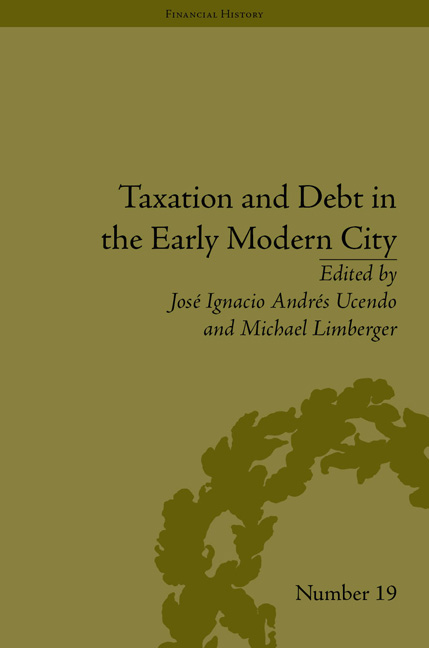Book contents
- Frontmatter
- CONTENTS
- Acknowledgements
- List of Contributors
- List of Figures and Tables
- Introduction
- 1 From Private to Public Management: Tax Farming and Customs Duties in Rome (1630–1700)
- 2 From Taxation to Indebtedness: The Urban Fiscal System of Milan during the Austrias Domination (1535–1706)
- 3 The Urban Tax System in the Kingdom of Naples (Seventeenth to Eighteenth Centuries)
- 4 Public Institutions, Local Politics and Urban Taxation in Seventeenth-Century Aragon
- 5 Taxation and Debt in the Early Modern Castilian Cities: The Case of Seventeenth-Century Madrid
- 6 Tax Collection in Spain in the Eighteenth Century: The Case of the ‘Décima’
- 7 Finances, the State and the Cities in France in the Eighteenth Century
- 8 The Making of the Urban Fiscal System of Antwerp until 1800: Excises, Annuities and Debt Management
- 9 The Dutch Financial System between Public and Private Interests: Urban Debt (1500–1700)
- 10 The Urban Fiscal System in the Habsburg Monarchy: The Case of the Austrian Hereditary Lands in the Sixteenth to Eighteenth Centuries
- 11 Taxation and Debt in Early Modern German Cities
- Notes
- Works Cited
- Index
9 - The Dutch Financial System between Public and Private Interests: Urban Debt (1500–1700)
- Frontmatter
- CONTENTS
- Acknowledgements
- List of Contributors
- List of Figures and Tables
- Introduction
- 1 From Private to Public Management: Tax Farming and Customs Duties in Rome (1630–1700)
- 2 From Taxation to Indebtedness: The Urban Fiscal System of Milan during the Austrias Domination (1535–1706)
- 3 The Urban Tax System in the Kingdom of Naples (Seventeenth to Eighteenth Centuries)
- 4 Public Institutions, Local Politics and Urban Taxation in Seventeenth-Century Aragon
- 5 Taxation and Debt in the Early Modern Castilian Cities: The Case of Seventeenth-Century Madrid
- 6 Tax Collection in Spain in the Eighteenth Century: The Case of the ‘Décima’
- 7 Finances, the State and the Cities in France in the Eighteenth Century
- 8 The Making of the Urban Fiscal System of Antwerp until 1800: Excises, Annuities and Debt Management
- 9 The Dutch Financial System between Public and Private Interests: Urban Debt (1500–1700)
- 10 The Urban Fiscal System in the Habsburg Monarchy: The Case of the Austrian Hereditary Lands in the Sixteenth to Eighteenth Centuries
- 11 Taxation and Debt in Early Modern German Cities
- Notes
- Works Cited
- Index
Summary
In the sixteenth and seventeenth centuries the Dutch Republic became a striking example of a capital-intensive state, in which taxation relied heavily on the cooperation between rulers and capitalists. The sale of urban and provincial annuities and the investment of citizens in such annuities and loans were a crucial part of this financial system for several reasons. First, taxation may have been the most import source of revenue for the Dutch Republic; a considerable part of the income of the state came from annuities and loans. The sale of annuities was an important source of income, particularly because loans were necessary for extraordinary expenses that could not be financed with regular tax money. Taxes and annuities were to a certain extent complementary. Second, the taxation system was often linked to the sale of annuities, and before the rise of a free capital market in the seventeenth century, coercion was a key factor in this. Sometimes additional taxes were imposed in the form of an annuity that would later be redeemed. Such renten were enforced contributions, quite similar to taxes. The legally forced nature of these loans makes it hard to discern between taxation and loans. Third, the financial success of the Dutch Republic between c. 1580 and 1650 was also made possible because taxes allowed for a funded debt. From 1547 onwards provincial annuities that were sold and managed by the cities created a debt that was backed by new permanent excises.
- Type
- Chapter
- Information
- Taxation and Debt in the Early Modern City , pp. 149 - 166Publisher: Pickering & ChattoFirst published in: 2014

